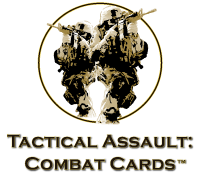Designer Q&A…
We often get some really great questions from folks about various aspects of the Combat Cards or the Fantasy cards. We decided to start having the designer of the rules tackle a few of them here on the website…
Why a diceless miniatures game? Do you simply hate dice, or were there other reasons?
Well, while every gamer has had their fair share of bad dice days, it really wasn’t why the games ended up being card driven. The card mechanic just offered the best way to bring together all of the elements we were trying to achieve with the rules:
- > The unpredictable friction of war which impacts every battle plan (e.g “These aren’t the cards I want right now…”)
- > The fog of war which affects every commander’s decision making process (e.g. “What cards does my opponent have?”)
- > The hard choices that a commander faces during a battle (e.g. ” Do I use the Action or the Situation on this card?”)
- > The variable outcomes of actual combat (e.g. a certain degree of randomness in results)
- > The desire to have a fast-playing, easy to learn system that could be expanded and tweaked to fit player preferences.
Why did you decide to go with generic unit types, like “Infantry” and “Armored”, rather than more specific units?
The primary goal of the generic units types was to allow for the rules to be versatile enough to handle just about any real or fictional genre a person wanted to play, while still maintaining the appropriate feel and flavor of the battlefield in terms of tactics, desirability of various units, etc.
For all intents and purposes there are certain basic relationships between units on the battlefield which we all expect to remain constant regardless of the specific forces being used – e.g. armored units alone can do little against aerial units, cavalry are more mobile than foot soldiers, anti-armor units are best against armored units, archers inflict their optimum casualties at a distance and so on.
In designing the games, those relationships were distilled down to their most basic form and then codified within the rules using the various actions, situations and generic unit types.
This structure allows players to utilize the appropriate rule set for their favorite genre by simply assigning each of their models (or “pieces” for you Legendary Battles players out there) a unit type based on the role the model or piece is intended to play on the battlefield.
If the players want to make some sort of adjustment for the forces they are using, or the period they are playing, all they have to do is adjust the unit types assigned to the models (e.g. in mid WW2 a Panther tank could be classified as a Behemoth unit due to its vastly superior abilities, but in a later war scenario it might just be classified as an Armored unit as the increased effectiveness of its foes in dealing with it, etc.). The actual rules themselves do not need to be changed.
Why was a narrative form of combat resolution used?
This was a deliberate choice made for two reasons:
First, it was to allow players to experience the battle as if they were a real battlefield commander rather than as a player playing a game (e.g. units are “shaken” for the moment or temporarily “out of action” rather than at a -2 morale check, or -5 to attack, etc.).
Second, it was chosen for the simplicity of the mechanic in facilitating rapid play (e.g. “…up one step for heavy firepower and up one for rear shot but down one for cover; flip the next card for combat results…”).
Keep an eye out for more Q&A from the designer each week…





